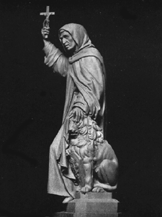The Church in Florence
 Florentine nobility derived most of their wealth from property. The church,
as it was, owned a great deal of property. The role of the church in
Florence
in the five centuries preceeding Galileo's birth was inextricably tied to
the political influence of land-ownership. Bishops governed large estates,
and exercised wide powers--creating an environment in Tuscany that has been
called "episcopal lordship."
Florentine nobility derived most of their wealth from property. The church,
as it was, owned a great deal of property. The role of the church in
Florence
in the five centuries preceeding Galileo's birth was inextricably tied to
the political influence of land-ownership. Bishops governed large estates,
and exercised wide powers--creating an environment in Tuscany that has been
called "episcopal lordship."
The authority and influence of church officials went well beyond the church
itself, and included the ability to tax. What resulted was a tendency on the part of bishops to live royal
lifestyles, and the intrusion of corruption into the affairs of the Florentine
church. In 1322, for example, a specially appointed papal commission met to
determine why the tythe collected in the Diocese of Florence by the late Bishop
Antonio degli Orsi had never made it to Rome. In looking for Pope John XXII's
money, the commission discovered that Bishop Antonio had been keeping two
palaces and a household of servants.
But the power inherent in the church's ownership of property is perhaps best
illustrated by the Visdomini. Highly prominent in Florentine church
history, this "kinship group," or "patrilineage" was a curious and unique
development. The Visdomini first appeared in 1009, serving as the lay
administrators of church estates in the period between the death of a bishop
and the election of his successor. Prior to this point, the role had always
been filled by a cleric, but it was thereafter in the hands of outside
families. Periods of administration sometimes lasted into the decades, making
the profession a rather lucrative business. The few families who made up the
Visdomini kept others out of their ranks and eventually rose into the
Tuscan elite.
Dante, in fact, attacked the Visdomini in his Paradiso, Canto XVI:
"And the balls of gold adorned Florence in all her great doings.
So did the fathers of those who, whenever your church is vacant,
fatten themselves by staying in consistory."1.
The center of religious life in Florence (as well as many aspects of
intellectual life, given its unprecented modern library) was the Convent
and Parish of San Marco. The monastary was
founded in 1290 by Sylvestrian monks, but Florentines petitioned the Pope
that they be removed in 1419 on account of "scandalous" activity. In 1436, Pope
Eugene IV transferred Reformed Dominicans to San Marco, at which time Cosimo
de' Medici commissioned the building of the library.
In 1482, a 30 year-old clerical reader came to San Marco for the first time.
His name was Girolamo Savonarola, and he came to epitomize the political
influence of the church in Florence. In 1487, Savonarola left San Marco only to
be invited back as a preacher, in 1490, by Lorenzo the Magnificent himself.
From the pulpit, he
soon became a powerful voice in Florentine politics. When the Medici's were
expelled from Florence following the 1494 French invasion of Tuscany, Savonarola
essentially became the ciy's theocratic dictator. His leadership was
authoritarian without question, but based entirely on ecclesiastical grounds.
He fell out of favor with the Pope, however, and was tortured and executed for
heresy in 1498.
By the time Galileo was born in 1564, the power of the local bishops had been
largely usurped by families such as the Mozzi, Bardi, and, of course, Medici.
But Florence had been permanently shaped by the political forces of the church.
Footnotes
1. Dameron, George W. Episcopal Power and Florentine
Society, 1000-1320. Cambridge: Harvard Univeristy Press, 1991. p. 2
Sources
Dameron, George W. Episcopal Power and Florentine Society, 1000-1320.
Cambridge: Harvard University Press, 1991.
Polizzotto, Lorenzo. The Elect Nation: The Savonarolan Movement in Florence
1494-1545. Oxford: Clarendon Press, 1994.
Ullman, Berthold L., and Philip A Stadter. The Public Library of Renaissance
Florence: Niccolo Niccoli, Cosimo de' Medici and the Library of San Marco.
Padova: Editrice Antenore, 1972.
 Florentine nobility derived most of their wealth from property. The church,
as it was, owned a great deal of property. The role of the church in
Florence
in the five centuries preceeding Galileo's birth was inextricably tied to
the political influence of land-ownership. Bishops governed large estates,
and exercised wide powers--creating an environment in Tuscany that has been
called "episcopal lordship."
Florentine nobility derived most of their wealth from property. The church,
as it was, owned a great deal of property. The role of the church in
Florence
in the five centuries preceeding Galileo's birth was inextricably tied to
the political influence of land-ownership. Bishops governed large estates,
and exercised wide powers--creating an environment in Tuscany that has been
called "episcopal lordship."